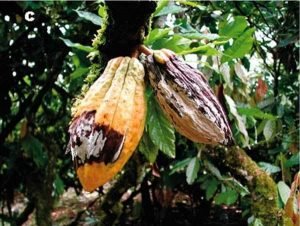Gene-Editing Tool CRISPR-Cas9: CRISPR stands for Clustered Regularly Interspaced Short Palindromic Repeats. In bacteria’s and in archaea CRISPR is a family of DNA sequence. The sequence contains the small pieces of viruses DNA that have attacked the prokaryotes.

These pieces used by prokaryotes to detect and destroy DNA from similar virus during the subsequent attacks. In prokaryotes defense system this sequence plays an important role and form the basis of technology known as CRISPR-cas9.with this we can fruitfully and specifically changes the gene within an organism.
Black Pod Rot Disease
Phytophthora palmivora and Phytophthora Phytophthora megakarya (plant destroyer) are the pathogens that cause black pod rot disease in cocoa trees. If we did not treat this pathogen it will destroy whole yield of cocoa trees. Cocoa trees grows in tropical regions and they produces the cocoa beans with the help of cocoa beans we can economically produce chocolates.
But each year almost 20-30 percent of cocoas plants are destroying by black pod rot disease.so improving disease resistance in cocoas trees are the first priority for researchers. The researchers recently reported in Frontiers in Plant Science, the results of their study of using CRISPR technology for the treatment of disease in Theobroma cocoa.
By using a DNA cutting enzyme cas9 in CRISPR technology we can modify the genome of an organism. The resulting change can delete or replace specific DNA piece there by promoting or disabling certain traits. TcNPR3 is a gene of cocoa tree it suppresses the disease response in plants. The researchers hypothesized that by using the CRISPR-Cas9 we can knock out this gene and enhance the resistance of disease.
Scientist tests this hypothesis on detached leaves of cocoa plants by using a plant pathogen called agrobacterium. Agrobacterium is a plant pathogen cause disease n plants. Scientists introduced CRISPR-Cas9 in detached cocoa leaves when they check the results almost 27% of the TcNPR3 gene was successfully removed from the leaves when infected with Phytopthera tropicalis.
A naturally occurring pathogen of cacao and other plants, the treated leaves showed greater resistance to the disease. The results suggested that the mutation of only a fraction of the copies of the targeted gene may be sufficient to trigger downstream processes, resulting in systemic disease resistance in the plant.
CRISPR gene edited cocoa embryo is also grown by the researchers these embryos will change into the mature trees with this method we can check the effectiveness of this technology in whole tree.
According to senior author Mark Guiltinan, professor of plant molecular biology and leader of Penn State’s endowed cocoa research program the conventional breeding and other old techniques is too slow for the treatment of this disease with the help of CRISPR technology we can speed up the recovery of cocoa trees. And produced more chocolates in future.
Conclusion
Use of the powerful gene-editing tool CRISPR-Cas9 could help to breed cacao trees that exhibit desirable traits such as enhanced resistance to black pod rot diseases.
